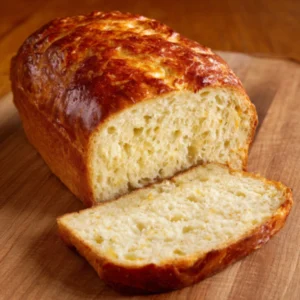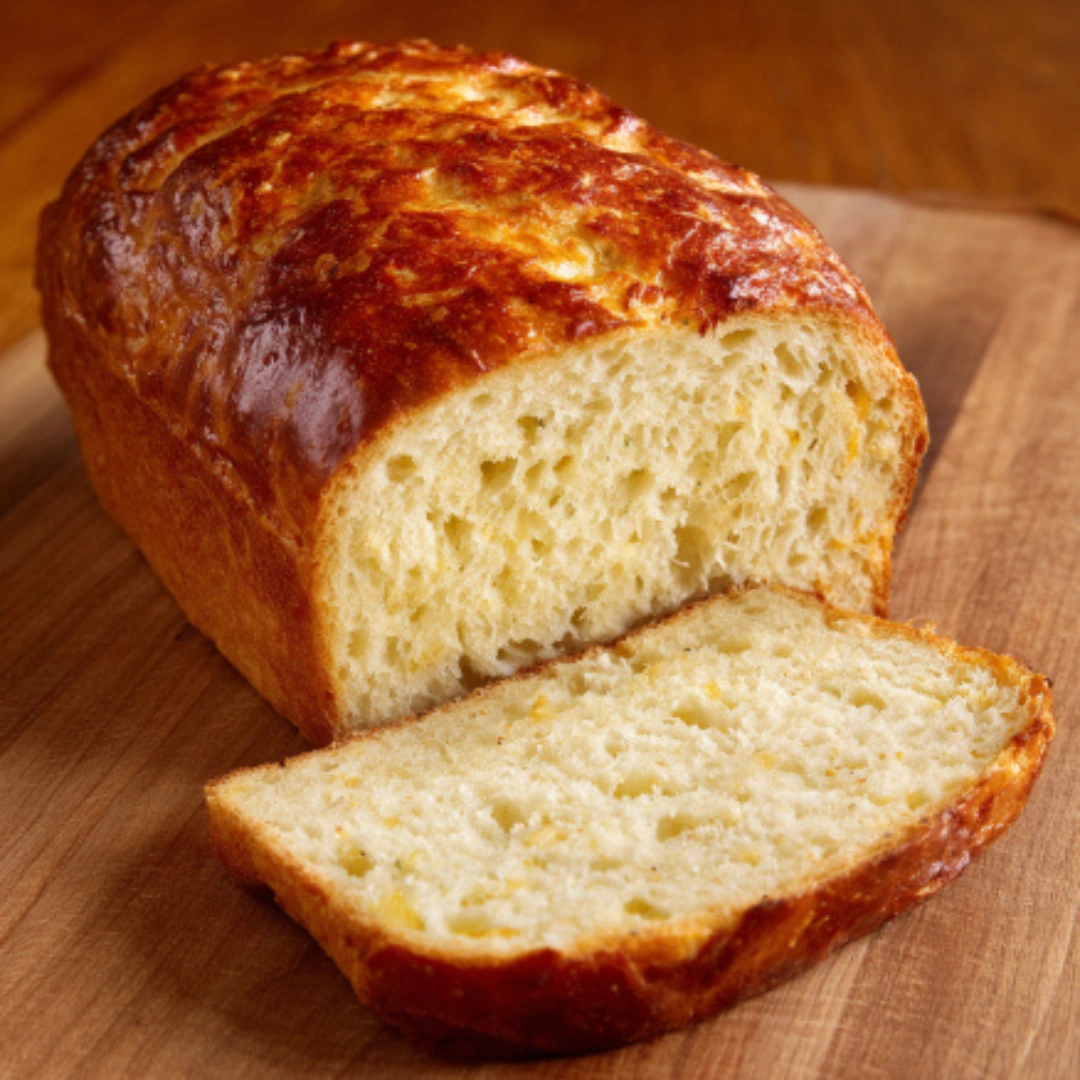When you think about homemade bread, you probably imagine a warm, soft loaf fresh out of the oven, filling your kitchen with that comforting aroma of yeast and butter. But have you ever tried making bread with cottage cheese? Cottage cheese bread takes the classic loaf you know and gives it a tender, moist texture with a subtle tang. Unlike plain sandwich bread, this version has extra protein, richness, and flavor that makes each slice special. You’ll find that it’s perfect for sandwiches, toasted with butter, or served alongside soups and salads.
Why We Love This Cottage Cheese Bread Recipe
There are many reasons why cottage cheese bread has become a go-to for home bakers. First, the texture is unbeatable. The cottage cheese keeps the loaf soft and moist without making it heavy. Unlike some breads that dry out quickly, this one stays tender for days.
Another reason to love this recipe is its nutritional boost. Cottage cheese adds protein and calcium, which means every slice is more satisfying. If you’re looking for a bread that keeps you full longer, this one fits the bill.
You’ll also appreciate how versatile it is. Toast it in the morning with jam, use it as the base for your favorite sandwich at lunch, or serve it alongside a bowl of chili for dinner. It can even be transformed into garlic bread or cheesy toast with a quick broil in the oven.
And finally, it’s approachable. Even if you’re new to yeast breads, the directions are straightforward, and the dough is forgiving. Once you get the hang of it, you’ll feel confident enough to experiment with herbs, cheese, or even sweet versions.
Ingredients for Cottage Cheese Bread
Here’s what you’ll need to bring this recipe to life. Each ingredient plays a role in building flavor, texture, and structure in the loaf.
- 2 ¼ teaspoons active dry yeast
- 1 tablespoon honey or sugar
- ½ cup warm water (110°F)
- 1 cup cottage cheese, room temperature and mashed or blended
- 1 large egg, beaten
- 2 tablespoons unsalted butter, melted
- 1 teaspoon salt
- 3 cups bread flour (or 2 ¾ cups all-purpose flour, adding more if needed)
Optional add-ins:
- ½ teaspoon garlic powder
- 1 teaspoon dried Italian herbs
- ½ cup shredded cheddar or parmesan
How to Make Cottage Cheese Bread Directions
Making cottage cheese bread is simpler than it looks. Follow each step carefully, and you’ll end up with a loaf that rivals anything from a bakery.
Step 1: Activate the yeast
Start by mixing the yeast, honey, and warm water in a small bowl. The water should feel warm to the touch but not hot—about 110°F is ideal. Let this mixture rest for 5 to 10 minutes until it becomes foamy. If bubbles don’t appear, it means the yeast isn’t active, and you’ll need to start again with a fresh packet. This step ensures your bread rises properly.
Step 2: Mix the wet ingredients
In a large mixing bowl, combine the cottage cheese (mashed or blended until smooth), the beaten egg, melted butter, and salt. Stir until the mixture is well blended. The cottage cheese adds richness and a subtle tang while the egg provides structure.
Step 3: Combine yeast with the wet mixture
Pour the activated yeast into the bowl of wet ingredients. Mix them together until combined. This step blends the tang of the cottage cheese with the sweetness of honey and the lift from the yeast, setting the stage for a flavorful loaf.
Step 4: Add the flour
Gradually add the flour one cup at a time, stirring until a soft dough forms. The dough will feel slightly sticky, but that’s what you want. If it’s too wet, add flour a tablespoon at a time until it comes together. The type of flour you use will affect the final result—bread flour makes a slightly chewier loaf, while all-purpose flour makes it lighter.
Step 5: Knead the dough
Turn the dough out onto a lightly floured surface. Knead by hand for 8 to 10 minutes, pushing, folding, and turning until it becomes smooth and elastic. If you have a stand mixer, use the dough hook on medium speed for about 6 minutes. The dough should pull away from the sides of the bowl and feel soft but not sticky.
Step 6: First rise
Place the dough in a lightly greased bowl and cover it with a clean kitchen towel. Let it rise in a warm place for 60 to 90 minutes, or until it doubles in size. A good trick is to place the bowl in a turned-off oven with the light on—it creates just the right amount of warmth for yeast to thrive.
Step 7: Shape the loaf
Once the dough has risen, punch it down gently to release air bubbles. Shape it into a smooth log and transfer it to a greased 9×5-inch loaf pan. Cover it again with a towel and let it rise for another 30 to 45 minutes. You’ll know it’s ready when the dough has puffed up and slightly overhangs the edge of the pan.
Step 8: Bake the bread
Preheat your oven to 375°F (190°C). Place the loaf pan in the oven and bake for 30 to 35 minutes. The bread should turn golden brown, and when you tap the bottom of the loaf, it should sound hollow. For precision, check with a kitchen thermometer—the internal temperature should read between 190°F and 200°F.
Step 9: Cool before slicing
Once baked, allow the loaf to cool in the pan for about 10 minutes. Then transfer it to a wire rack to cool completely. Resist the urge to slice into it right away; cooling helps the bread set and keeps it moist inside.
How to Serve Cottage Cheese Bread
There are endless ways to enjoy your freshly baked loaf. At its simplest, you can slice and toast it with butter for breakfast. The creamy tang of cottage cheese pairs beautifully with a swipe of jam, honey, or nut butter.
For lunch, use it as the base for sandwiches. Because it’s soft yet sturdy, it holds up well to hearty fillings like roasted vegetables, chicken salad, or tuna. You can also grill it for a warm panini-style sandwich.
At dinner, this bread shines alongside soups and stews. A thick slice dunked into tomato soup or served with chili makes a comforting meal. It also works well as a side for pasta or salad. For a special twist, turn it into garlic bread by brushing slices with butter, sprinkling with garlic powder, and broiling for a few minutes until crisp.
Expert Tips: Cottage Cheese Bread
To ensure your bread turns out perfect every time, keep these expert tips in mind:
- Use full-fat cottage cheese. This makes the loaf richer and more tender. Low-fat versions can work, but the texture won’t be as soft.
- Mash or blend the cottage cheese. This prevents lumps and ensures a smooth dough.
- Choose the right flour. Bread flour gives you more structure, while all-purpose flour creates a lighter loaf. Both work—pick based on your preference.
- Adjust flour as needed. The dough should be slightly sticky but manageable. Add flour a tablespoon at a time if it feels too wet.
- Create a warm environment for rising. If your kitchen is cool, use the oven trick with just the light on.
- Check doneness with a thermometer. An internal temperature of 190–200°F guarantees a fully baked loaf.
How to Store Cottage Cheese Bread
Homemade bread is always best enjoyed fresh, but proper storage can help it last longer. Keep your loaf in an airtight container or a bread box at room temperature for up to 3 days. If you live in a warm climate, you may want to refrigerate it, though that can make bread dry faster.
For longer storage, freeze the bread. Wrap it tightly in plastic wrap, then place it in a freezer bag. It will keep for up to 3 months. To enjoy later, thaw it at room temperature, then toast or warm it in the oven at 300°F for about 10 minutes to refresh its texture.
Variations of Cottage Cheese Bread
Once you master the base recipe, you can get creative with different variations.
- Herb-infused loaf: Add 1 teaspoon dried Italian herbs and ½ teaspoon garlic powder to the dough for a fragrant, savory twist.
- Cheese bread: Fold in ½ cup shredded cheddar or parmesan for an extra cheesy loaf that pairs perfectly with pasta dishes.
- Seeded bread: Sprinkle sesame, sunflower, or flax seeds on top before baking for crunch and added nutrition.
- Sweet version: Add a tablespoon of sugar and a handful of raisins or dried cranberries for a breakfast-friendly bread.
- Whole grain version: Replace 1 cup of bread flour with whole wheat flour for a heartier, nutty flavor.
FAQ: Cottage Cheese Bread
What does cottage cheese do in bread?
Cottage cheese adds moisture, protein, and a subtle tang to bread. It helps the loaf stay soft for longer and gives it a richer flavor.
Can you use low-fat cottage cheese?
Yes, but full-fat cottage cheese makes the bread more tender and flavorful. Low-fat versions will still work but may give a slightly drier texture.
Do I need bread flour, or can I use all-purpose?
You can use either. Bread flour produces a chewier texture, while all-purpose creates a softer, lighter loaf.
Why didn’t my bread rise?
This usually happens if the yeast wasn’t active. Always check that your yeast foams during the activation step. Also, make sure the dough has enough warmth to rise.

Cottage Cheese Bread
Equipment
- Mixing Bowl
- Loaf Pan
- Measuring Spoons
- Stand mixer or kneading surface
Ingredients
- 2 1/4 tsp active dry yeast
- 1 Tbsp honey or sugar
- 1/2 cup warm water 110°F
- 1 cup cottage cheese room temperature, mashed or blended
- 1 large egg beaten
- 2 Tbsp unsalted butter melted
- 1 tsp salt
- 3 cups bread flour or 2 3/4 cups all-purpose flour, adding more if needed
- 1/2 tsp garlic powder optional
- 1 tsp dried Italian herbs optional
- 1/2 cup shredded cheddar or parmesan optional
Instructions
- In a small bowl, mix yeast, honey, and warm water. Let it rest for 5-10 minutes until foamy.
- In a large mixing bowl, combine cottage cheese, beaten egg, melted butter, and salt. Stir until well blended.
- Add the activated yeast to the wet mixture and mix until combined.
- Gradually add flour one cup at a time, stirring until a soft dough forms.
- Knead the dough on a floured surface for 8-10 minutes, or use a stand mixer with a dough hook for about 6 minutes.
- Place the dough in a greased bowl, cover with a towel, and let it rise in a warm place for 60-90 minutes, or until doubled in size.
- Punch down the dough, shape it into a log, and transfer it to a greased 9×5-inch loaf pan. Cover and let it rise for another 30-45 minutes.
- Preheat the oven to 375°F (190°C) and bake the loaf for 30-35 minutes until golden and hollow-sounding when tapped.
- Allow the bread to cool in the pan for 10 minutes before transferring it to a wire rack to cool completely.
Send me this recipe!
Just enter your email below and get it sent straight to your inbox!



